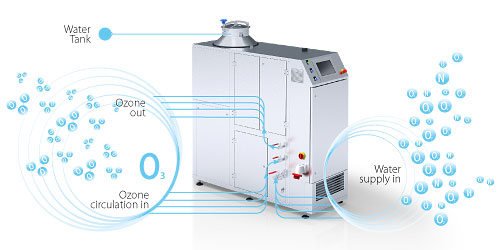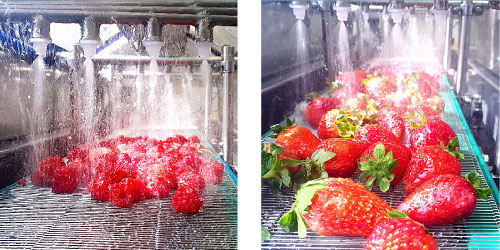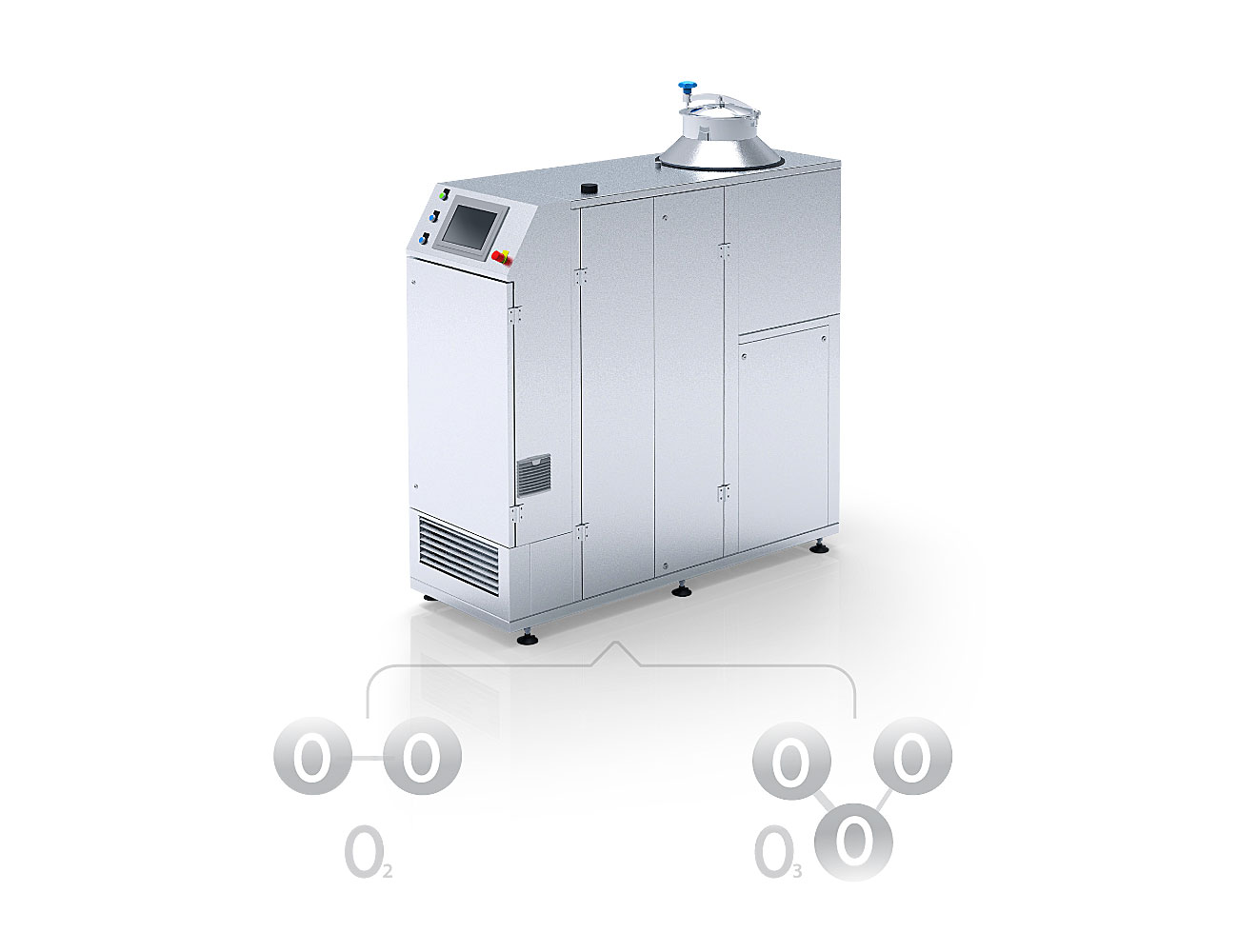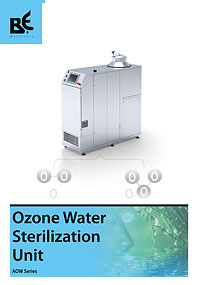Ozone Water Sterilization Unit
Ozone Water Sterilisation UnitThe Principle Function:
The markets has an increasing demand for fruits, vegetables and salads clean of any contamination from pathogens and chemical contaminants or detergents.
Ozonized water is used in a variety of operations to wash fruits and vegetables including ready to eat salad products.
Ozone is a more powerful disinfectant than Hydrogen Peroxide, chlorine, chlorine dioxide and many of the industry disinfectant agents. Ozone is effective against an Extremely wide range of pathogens .
Ozone is said to be about 50% more powerful and to act 3,000 times faster than chlorine at 100 times the strength.
More to add, in the water, ozone has a lifespan of 10 to 20 minutes only, after which it breaks down to oxygen. Therefore the Ozone does not leave any harmful byproducts as other disinfectors do. This prevents contamination of the products with any byproducts pollution and also allows easy discharge of the used wash water.
What is OZONE and how is it produced?
Ozone (O3) is a powerful gas molecule consists of three oxygen atoms formed by dissociating two atoms that compose the oxygen gas. Each atom of oxygen released binds to another molecule of oxygen (O2) to form ozone molecules (O3).
Due to it’s unique chemical composition and highly reactive nature,ozone is able to quickly and efficiently disinfect and oxidize a wide variety of microorganisms, faster than any other commercially available oxidant. Ozone begins oxidizing everything immediately upon contact, powerfully breaking down bacteria and viruses.
As ozone decontaminates, it naturally decomposes back into oxygen, without leaving toxic residues, making it safe for the environment.
Ozone Wash in Act:
Even the most Vulnerable and sensitive fruits can get extended shelf life with the treatment of Ozone wash


Advantages of Ozone
- Ozone is the most powerful oxidant for disinfecting water or sanitizing surfaces
- Ozone can kill pathogens in seconds vs. several minutes for other oxidants
- Ozone is one of the strongest oxidant available for oxidizing organics
- Ozone decomposes into oxygen
- Ozone, by itself, does not affect pH
- Ozone cannot be stored; therefore, having a large volume of a dangerous oxidizer is not possible
- Ozone is excellent at oxidizing metals such as iron, manganese, and more
- Ozone enhances the flocculation and coagulation of organic material thereby improving filtration
- Ozone can be effective in partially oxidizing organics in the water to biodegradable compounds that can be removed by biological filtration
- Up to this date, there has not been a single bacteria, virus or cyst discovered that can withstand Ozone!
Ozone destroys all molds, viruses and bacteria common in the food industry:
• Aspergillus Niger (Black Mount), Destroyed by 1.5 to 2 mg/I • Bacillus Bacteria, Destroyed by 0.2 m/I within 30 seconds • Bacillus Anthracis, Ozone susceptible • Bacillus Cereus, 99% destruction after 5 min at 0.12 mg/l in water • B. Cereus (Spores), 99% destruction after 5 min at 2.3 mg/l in water • Bacillus Subtilis, 90% reduction at 0.10 PPM for 33 minutes • Bacteriophage f2, 99.99% destruction at 0.41 mg/l for 10 seconds in water • Botrytis Cinerea, 3.8 mg/l for 2 minutes • Candida Bacteria, Ozone susceptible • Clavibacter michiganense, 99.99% destruction at 1.1 mg/l for 5 minutes • Cladosporium, 90% reduciton at 0.10-PPM for 12.1 minutes • Clostridium Bacteria, Ozone susceptible • Clostridium Botulinum (Spores), 0.4 to 0.5 mg/l threshold value • Coxsackie Virus A9, 95% destruciton at 0.035 mg/l for 10 seconds in water • Coxsackie Virus B5, 99.99% desctruction at 0.4 mg/l for 2.5 minutes in sludge effluent • Diphtheria Pathogen, Destroyed by 1.5 to 2 mg/l • Eberth Bacillus (Typhus Abdomanalis), Destroyed by 1.5 to 2 mg/l • Echo Virus 29: The virus most sensitive to ozone. After a contact time of 1 minute at 1 mg/l of ozone, 99.999% killed • Enteric Virus, 95% destruction at 4.1 mg/l for 29 minutes in raw wastewater • Escherichia Coli Bacteria (from feces), Destroyed by 0.2 mg/l within 30 seconds in air • E-coli (in clean water), 99.99% destruction at 0.25 mg/l for 1.6 minutes • Encephalomyocarditis Virus, Destroyed to zero level in less than 30 seconds with 0.1 to 0.8 mg/l • Endamoebic Cysts Bacteria, Ozone susceptible • Enterovirus Virus, Destoryed to zero level in less than 30 seconds with 0.1 to 0.8 mg/l • Fusarium Oxysporium f sp. Lycopersici, 1.1 mg/l for 10 minutes • Fusarium Oxysporium f sp. Melonogea, 99.99% destruction at 1.1 mg/l for 20 minutes • GDVII Virus, Destroyed to zero level in less than 30 seconds with 0.1 to 0.8 mg/l • Hepatitus A Virus, 99.5% reduction at 0.25 mg/l for 2-seconds in a phosphate buffe • Herpes Virus, Destroyed to zero level in less than 30 seconds with 0.1 to 0.8 mg/l • Influenza Virus, 0.4 to 0.5 mg/l threshold value • Klebs-Loffler Bacillus, Destroyed by 1.5 to 2 mg/ • Legionella Pneumophila, 99.99% destruciton at 0.32 mg/l for 20 minutes in distilled water • Luminescent Basidiomycetes, Destroyed in 10 minutes at 100-PPM • Mucor Piriformis, 3.8 mg/l for 2 minutes • Mycobacterium Avium, 99.9% with a CT value of 0.17 in water • Mycobacterium Foruitum, 90% destruction at 0.25 mg/l for 1.6 minutes in water • Penicillium Bacteria, Ozone susceptible • Phytophthora Parasitica, 3.8 mg/l for 2 minutes • Poliomyelitis Virus, 99.99% kill with 0.3 to 0.4 mg/l in 3-4 minutes • Poliovirus Type 1, 99.5% destruction at 0.25 mg/l for 1.6 minutes in water • Proteus Bacteria, Very susceptible • Pseudomonas Bacteria, Very susceptible • Rhabdovirus virus, Destroyed to zero level in less than 30 seconds with 0.1 to 0.8 mg/l • Salmonella Bacteria, Very susceptible • Salmonella typhimurium, 99.99% destruction at 0.25 mg/l for 1.67 minutes in water • Schistosoma Bacteria, Very susceptible • Staph epidermidis, 90% reduction at 0.1-ppm for 1.7 min • Staphylococci, Destroyed by 1.5 to 2.0 mg/l • Stomatitis Virus, Destroyed to zero level in less than 30 seconds with 0.1 to 0.8 mg/l • Streptococcus Bacteria, Destroyed by 0.2 mg/l within 30 seconds • Verticillium dahliae, 99.99 % destruction at 1.1 mg/l for 20 minutes • Vesicular Virus, Destroyed to zero level in less than 30 seconds with 0.1 to 0.8 mg/l • Virbrio Cholera Bacteria, Very susceptible • Vicia Faba progeny, Ozone causes chromosome aberration and its effect is twice that observed by the action of X-rays
Source: Ozone cip project – Study of ozone technology, public report
Ozone Compare
| Oxidizing Reagent | Oxidizing Potential(eV – Electronvolt) |
|---|---|
| Ozone | 2.07 |
| Hydrogen Peroxcide | 1.77 |
| Permanganate | 1.67 |
| Hypochlorous Acid | 1.49 |
| Chlorine Gas | 1.36 |
| Hypobromous Acid | 1.33 |
| Oxygen | 1.23 |
| Bromine | 1.09 |
| Hypoiodous Acid | 0.99 |
| Hypochlorite | 0.94 |
| Chlorite | 0.76 |
| Iodine | 0.54 |
Source: Ullmanns, 1991
 English
English Русский
Русский


